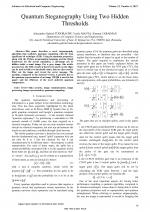| 4/2021 - 9 |
Quantum Steganography Using Two Hidden ThresholdsTUDORACHE, A.-G. |
| Extra paper information in |
| Click to see author's profile in |
| Download PDF |
Author keywords
data security, image communication, image processing, image representation, quantum computing
References keywords
quantum(45), process(20), steganography(19), image(15), images(8), zhou(7), novel(7), representation(5), protocol(5), digital(5)
Blue keywords are present in both the references section and the paper title.
About this article
Date of Publication: 2021-11-30
Volume 21, Issue 4, Year 2021, On page(s): 79 - 88
ISSN: 1582-7445, e-ISSN: 1844-7600
Digital Object Identifier: 10.4316/AECE.2021.04009
Web of Science Accession Number: 000725107100009
SCOPUS ID: 85122237281
Abstract
This paper describes a novel steganography algorithm that combines quantum computing with the least significant bit technique (LSB). Using the quantum properties, along with the Python programming language and the Qiskit framework for the circuit simulation, a sub-image can be hidden inside a usual image. For a gray image, this article presents how the LSB of each of the first 16 pixels on the edges can be used to hide two threshold values, that are then used to filter out the image and reveal the secret message. The speedup, compared to the classical version, is possible due to the quantum representation of an image (NEQR is used in this paper) and the efficiency of the novel multi-bit quantum comparators. |
| References | | | Cited By |
Web of Science® Times Cited: 0
View record in Web of Science® [View]
View Related Records® [View]
Updated 3 weeks, 5 days ago
SCOPUS® Times Cited: 2
View record in SCOPUS® [Free preview]
View citations in SCOPUS® [Free preview]
[1] PREREQUISITES FOR THE ESTABLISHMENT OF A QUANTUM STEGANOGRAPHY COMMUNICATION, Stoyanova, Veselka, ENVIRONMENT. TECHNOLOGY. RESOURCES. Proceedings of the International Scientific and Practical Conference, ISSN 2256-070X, Issue , 2025.
Digital Object Identifier: 10.17770/etr2025vol5.8485 [CrossRef]
[2] Quantum Image Steganography Schemes for Data Hiding: A Survey, Min-Allah, Nasro, Nagy, Naya, Aljabri, Malak, Alkharraa, Mariam, Alqahtani, Mashael, Alghamdi, Dana, Sabri, Razan, Alshaikh, Rana, Applied Sciences, ISSN 2076-3417, Issue 20, Volume 12, 2022.
Digital Object Identifier: 10.3390/app122010294 [CrossRef]
[3] Empirical Analysis of Quantum Compution using Qiskit Framework, Palsodkar, Prachi, Khandare, Akshay, Raut, Akanksha, Giradkar, Vidhi, Dekate, Swapna, Rokade, Rahul, 2023 9th International Conference on Advanced Computing and Communication Systems (ICACCS), ISBN 979-8-3503-9737-6, 2023.
Digital Object Identifier: 10.1109/ICACCS57279.2023.10112866 [CrossRef]
[4] Enhance Approach on Steganography Using Quantum Computing, Jain, Ayush V, Singh, Ayush, Satapathy, Ashirbad, Shyry, S. Prayla, 2023 International Conference on Computing, Communication, and Intelligent Systems (ICCCIS), ISBN 979-8-3503-0611-8, 2023.
Digital Object Identifier: 10.1109/ICCCIS60361.2023.10425760 [CrossRef]
Disclaimer: All information displayed above was retrieved by using remote connections to respective databases. For the best user experience, we update all data by using background processes, and use caches in order to reduce the load on the servers we retrieve the information from. As we have no control on the availability of the database servers and sometimes the Internet connectivity may be affected, we do not guarantee the information is correct or complete. For the most accurate data, please always consult the database sites directly. Some external links require authentication or an institutional subscription.
Web of Science® is a registered trademark of Clarivate Analytics, Scopus® is a registered trademark of Elsevier B.V., other product names, company names, brand names, trademarks and logos are the property of their respective owners.
Faculty of Electrical Engineering and Computer Science
Stefan cel Mare University of Suceava, Romania
All rights reserved: Advances in Electrical and Computer Engineering is a registered trademark of the Stefan cel Mare University of Suceava. No part of this publication may be reproduced, stored in a retrieval system, photocopied, recorded or archived, without the written permission from the Editor. When authors submit their papers for publication, they agree that the copyright for their article be transferred to the Faculty of Electrical Engineering and Computer Science, Stefan cel Mare University of Suceava, Romania, if and only if the articles are accepted for publication. The copyright covers the exclusive rights to reproduce and distribute the article, including reprints and translations.
Permission for other use: The copyright owner's consent does not extend to copying for general distribution, for promotion, for creating new works, or for resale. Specific written permission must be obtained from the Editor for such copying. Direct linking to files hosted on this website is strictly prohibited.
Disclaimer: Whilst every effort is made by the publishers and editorial board to see that no inaccurate or misleading data, opinions or statements appear in this journal, they wish to make it clear that all information and opinions formulated in the articles, as well as linguistic accuracy, are the sole responsibility of the author.



